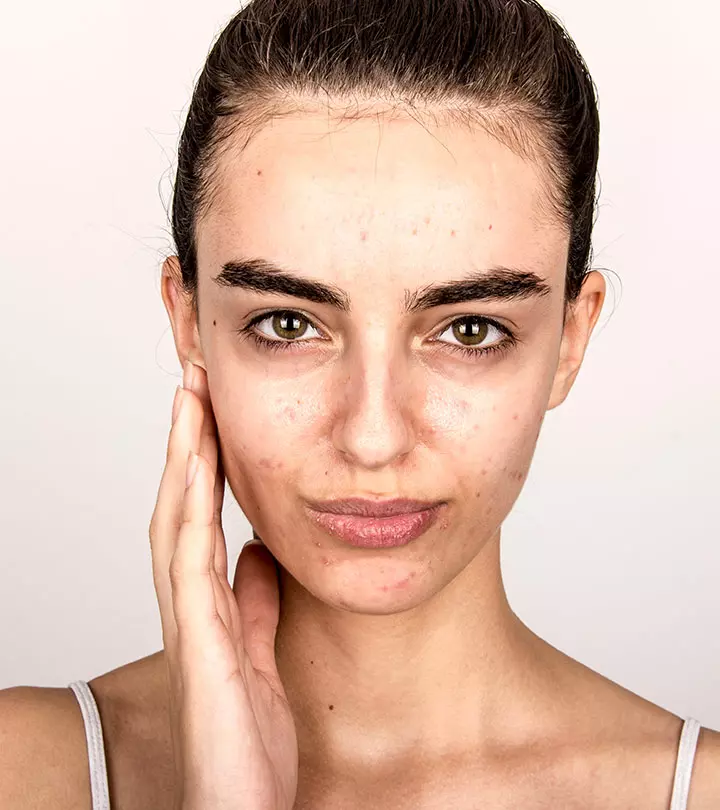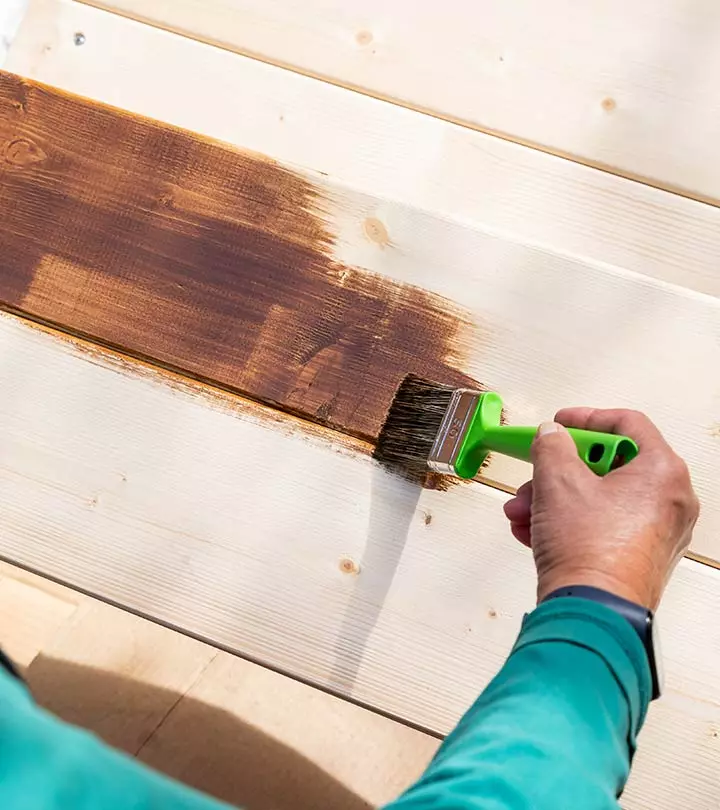What To Do After Popping A Pimple: 5 Expert Aftercare Steps
What to do and what not to do when it comes to getting rid of those pesky bumps.

Image: shutterstock
We should avoid picking at our pimples. However, most of us can not resist the urge to play Dr. Pimple Popper, and that is when the trouble starts. Most of us don’t know much about what to do after popping a pimple and how to care for it. Scratching and popping a pimple with zero aftercare can lead to scars and dark spots. Don’t worry. We can help you with the aftercare and prevent unwanted side effects. Keep reading to learn more.
In This Article
What To Do After Popping A Pimple
1. Do Not Pick At The Pimple
So you have popped the pimple. Avoid messing with it anymore. Do not pick at it and scratch it or keep squeezing it. Even if it develops a pus-filled head again, leave it alone and let your skin take care of the infection.
2. Cleanse The Blemish
Cleanse the zit gently. Use a salicylic-acid based cleanser. Avoid rubbing it too hard to prevent the risk of disturbing the zit. Don’t rub a towel to dry the skin. Gently dab with a cotton cloth. You can also use cleansers with witch hazel to reduce inflammation. Avoid trying DIY hacks at this point to avoid blemishes and scarring.
 Quick Tip
Quick Tip3. Use Spot Treatment
Use an antibiotic ointment and spot treatments containing tea tree oil and witch hazel extract to reduce inflammation. Witch hazel has astringent effects and anti-inflammatory properties to calm down redness and swelling. On the other hand, tea tree oil can kill acne-causing bacteria. You can dab the zit with witch hazel solution and diluted tea tree oil.
4. Control Swelling With Ice
An ice pack can reduce the redness and soreness after popping a pimple. Wrap ice cubes in a clean cloth or use an ice pack. However, this method is generally not recommended by dermatologists as it can result in cold-induced injuries.

Asha, a YouTuber, shares her DIY tips on acne and pimples, highlighting the efficacy of her ice method. She expresses, “Not only does this method cool my skin, but it also helps to improve my skin (i).” She further adds, “It helps calm redness and swelling, and also avoids any upcoming pimple that is trying to peek through.”
5. Consult A Dermatologist
Start acne prevention treatment to prevent further breakouts. Consult your dermatologist for prescription acne products and antibiotics (if needed). Early treatment prevents the risk of scarring and blemishes.
Our skin and body have a natural healing system. When you pop a pimple, you interfere with the process, leading to further damage. Here is why you should avoid popping a pimple in the first place.
Key Takeaways
- Once you’ve popped a pimple, avoid picking at it. Instead, gently cleanse the popped zit and use a spot treatment.
- Reduce redness and swelling with ice, and consult a dermatologist for recommended acne prevention treatments.
- Avoid popping pimples as much as possible. This may otherwise cause infections, scarring, and hyperpigmentation.
- Instead, use products with active ingredients, pimple patches, and follow a proper skin care routine to reduce pimples.
Why Should You Avoid Popping Your Pimples?
1. Risk Of Infections
Popping a pimple aggravates the bacterial infection. There is always a risk of transferring dirt and bacteria from our nails and fingers to the inflamed zit. Moreover, this can prolong the healing time.
2. Scarring And Hyperpigmentation
Picking at a zit can be counterproductive as it creates open wounds, and the skin may develop scars and dark spots.
As part of a study on the prevalence of acne scars and its risk factors, 24,649 acne patients were surveyed. 47% of them were found to have acne scars. Notable risk factors included male gender, positive family history of acne, and acne severity. Early attention and effective acne therapy are crucial to minimize scarring.
Instead of popping the pimples, you can try the following alternatives to speed up the healing process.
Alternatives For Popping A Pimple
1. Products With Active Ingredients
Using products like creams, moisturizers, and cleansers containing active ingredients like benzoyl peroxide and salicylic acid can help reduce the inflammation and clear the pimple. They promote skin exfoliation to clean the dirt, sebum, and bacteria to promote healing.
2. Pimple Patches
These are hydrocolloid patches that absorb the pus from the pimple, keep the area moisturized, and promote healing. These patches also shield the pimple from dust and dirt and prevent you from picking at it.
3. Follow Proper Skin Care Routine
Wash your face twice a day to reduce inflammation. You may use chemical exfoliators in low concentrations (if you haven’t popped the pimple) and keep the area moisturized. A proper skin care routine prevents the pimple from worsening.
 Pro Tip
Pro TipIf you cannot resist the urge to give it a good squeeze, you should at least do it safely. While we do not recommend popping a pimple, here are a few tips to follow to pop your zits safely.
How To Safely Pop A Pimple
1. Wash your hands thoroughly before touching your skin. It will prevent the germs on your hands from infecting the skin around the pimple.
2. Apply a warm compress or wash your skin with warm water to loosen the dirt.
3. Sterilize a pin with a lighter and let it cool down. Then, wipe it with rubbing alcohol.
4. Wrap your fingers with a clean tissue and hold the pin parallel to the zit.
5. Gently pierce the pus-filled head of the pimple.
6. Squeeze it with a cotton swab. Press around the zit and not on the pus-filled center.
7. If the pus does not come out easily, the pimple is not ready to be popped. Stop immediately.
8. Apply an antibacterial ointment or witch hazel to the area.
9. After a while, clean the area and apply a pimple patch.
10. You can use an ice pack to relieve redness and soreness.
In case you do not want to pop a pimple but are afraid you might do it accidentally, the tips in the following section might help you.
How To Stop Popping Pimples?
Here are some tips to help you deal with the urge to pop your pimples.
- Remind yourself not to touch your face throughout the day.
- Occupy your hands with other activities to divert attention from the urge to pop pimples.
- Apply spot treatments or acne patches to actively address the pimple without squeezing.
- Visualize potential scarring or worsening of the blemish to discourage yourself from picking.
- Trim your nails to minimize the damage caused by scratching.
- Share your goal of not popping pimples with a friend or family member who can provide encouragement.
- Practice mindfulness or meditation to reduce stress, a common trigger for impulsive behaviors, which may lead to picking.
- Establish a consistent skin care routine to address acne.
In case of stubborn pimples, you may have to consult your dermatologist.
When To Consult A Dermatologist
If the pimples refuse to go away or keep coming back, consult your dermatologist. Recurrent and stubborn pimples may need antibiotics to kill the bacteria. In such cases, the doctor can prescribe medicines and ointments, depending on the severity of your condition.
We all have done it at some point and immediately regret our decision to pick at the pimple. However, now you have a clear idea about what you must do after popping a pimple. While it is best not to touch the pimple and use patches or medications to minimize the inflammation, you can still manage the popped zit and avoid blemishes. Use topical medications and ice packs to soothe the zit and follow the tips discussed in the article to avoid pain and infection.
Frequently Asked Questions
What happens when you pop a pimple and blood comes out?
When blood comes out of a pimple after popping it, it means it is now scabbing over and healing.
What is the white stuff in a pimple?
The white stuff in a pimple is pus, sebum, bacteria, and dead skin cells.
What is the hard ball in a pimple?
The hard ball in a pimple is the pus, which contains dead white blood cells. This can result in what is often referred to as a “hard pimple,” which may feel more solid and be more painful than regular pimples.
Watch this informative video for proper post-pimple care. Learn essential steps to soothe and heal your skin after popping a pimple, using spot treatments and applying soothing agents to minimize scarring and expedite the healing process for clearer, healthier skin.
Personal Experience: Source
StyleCraze's articles are interwoven with authentic personal narratives that provide depth and resonance to our content. Below are the sources of the personal accounts referenced in this article.
(i) Ice cube : Home Remedy for Acnehttps://www.youtube.com/watch?v=phSGLlSKVfk&t=17s
References
Articles on StyleCraze are backed by verified information from peer-reviewed and academic research papers, reputed organizations, research institutions, and medical associations to ensure accuracy and relevance. Read our editorial policy to learn more.
- The efficacy of 5% topical tea tree oil gel in mild to moderate acne vulgaris: a randomized double-blind placebo-controlled study
https://pubmed.ncbi.nlm.nih.gov/17314442/ - Antioxidant and potential anti-inflammatory activity of extracts and formulations of white tea rose and witch hazel on primary human dermal fibroblast cells
https://www.ncbi.nlm.nih.gov/labs/pmc/articles/PMC3214789/ - Over-the-counter Acne Treatments
https://www.ncbi.nlm.nih.gov/pmc/articles/PMC3366450/
Read full bio of Dr. Nermeen Bedair
Read full bio of Ramona Sinha
Read full bio of Anjali Sayee
Read full bio of Swathi E




























Community Experiences
Join the conversation and become a part of our empowering community! Share your stories, experiences, and insights to connect with other beauty, lifestyle, and health enthusiasts.